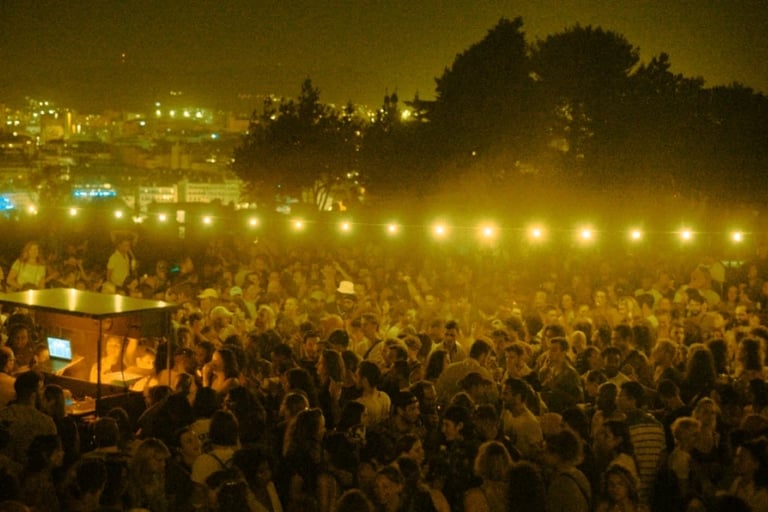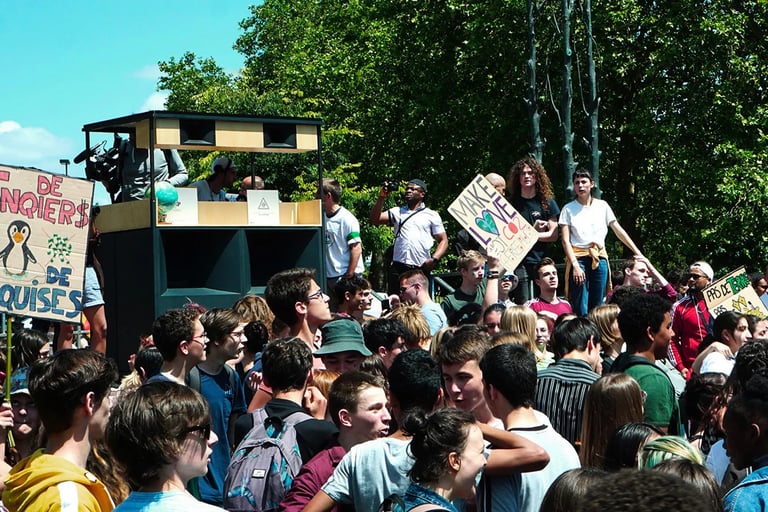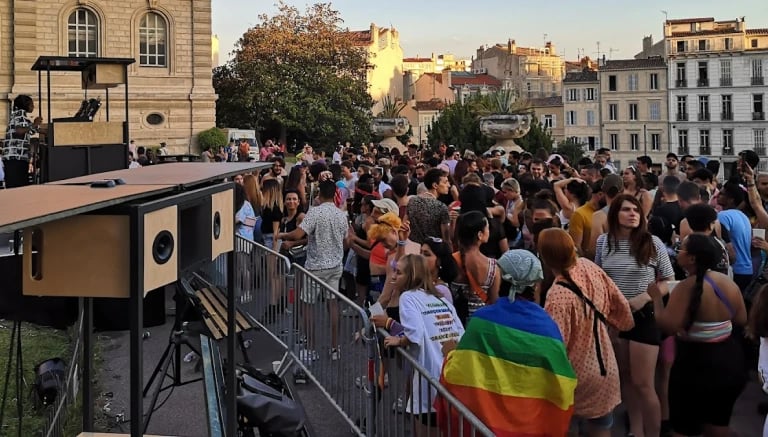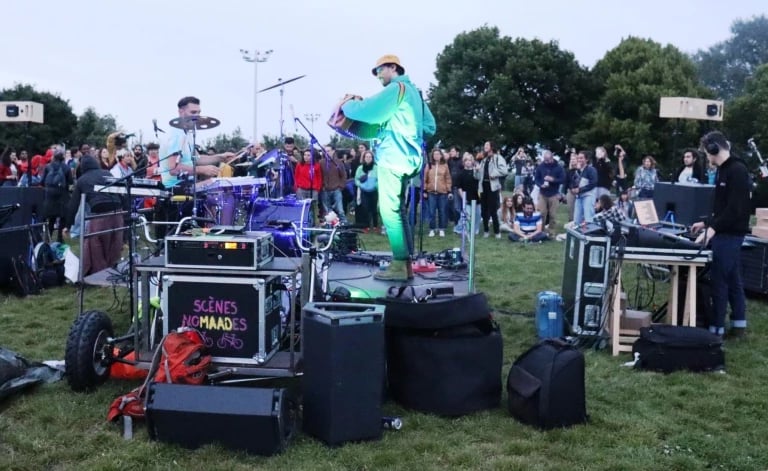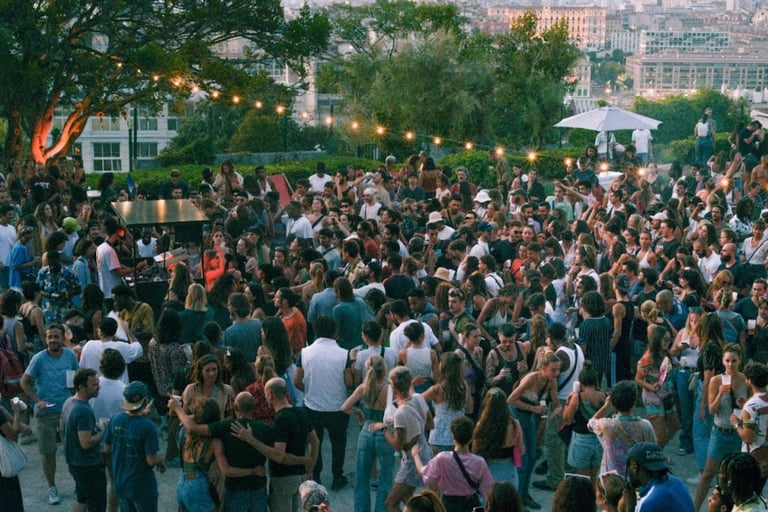PIKIP SOLAR DJ powered by the SUN
MUSIC
Music and word #redhotchillipapers #californication We were told everything a long time ago, we just didn't pay attention now when you connect the dots it all makes sense
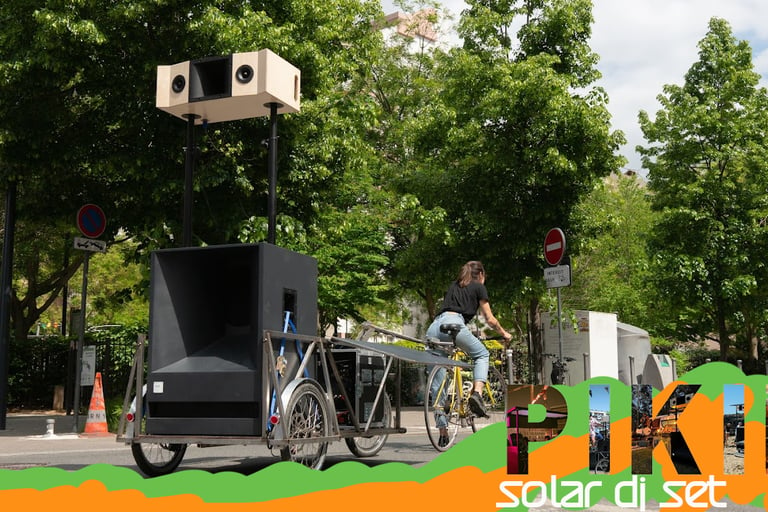

Interview with Julien Feuillet and Solal Bouchet from Pikip Solar Speakers
March 25, 2023 By sonolight.fr/
Created by Julien Feuillet and Maatea Stabile, the Marseille company Pikip has been offering solar diffusion solutions for more than five years, and therefore energy autonomous: a project that ticks so many boxes in its uses as in its philosophy that it has cited as an example by the Shift Project. There was therefore no way to spend this Green Month without speaking with Julien, energy engineer, and Solal Bouchet, electroacoustics engineer, to find out more about their approach which, without a doubt, shapes the future of sound and live entertainment…
Making of a speaker
How was the idea for Pikip born?
Julien: I am an energy engineer specializing in solar energy and I have worked with people on architectural work, particularly in Paris. Like any good living person, I love parties, I love festivals and I have always been immersed in it with my group of friends. And it's true that this dream of being autonomous on a professional sound system and not depending on people is something that has been in our minds for several years. And then, the construction industry got the better of me. I resigned and threw myself into this project, at first just to have fun, to keep myself busy.
I was in my cellar in Paris, near République, and I started to measure all this a little bit. And I very quickly realized that if we wanted to do something professional, that is to say with power and quality, reliability and autonomy that speak to professionals, connect lambda speakers to lambda brands behind solar panels wouldn't be enough. We had to dig a little deeper into the power demands, the notion of efficiency... And I very quickly realized that the project had its limits if we remain compartmentalized to that.
I was all alone in my cellar, between the cars parked sending big techno in a parking lot that scared old people
Julien: At that time, I lived next to the Maison du Haut Parleur in Paris and I was able to meet our mentor who still gives us his tough advice today: David Rousseau, or Monsieur Basses Frequencies in Île-de-France. France, who directed me towards theater voices. Without pre-treating me, he said to me, “Here, look at this and go have fun.” We'll meet again in six months..." Six months later, we meet again and in the meantime, I was able to find six voices from the theater that I went to look for in a cinema in Boulogne which was going to be demolished. Then I was able to start measuring the bikes and see that indeed, working on the yield of the bodies could make the project viable. I then did the first module which was Booth V0: I was all alone in my cellar, between the cars parked sending big techno into a parking lot that scared the old people. And I immediately offered this product to Parisian underground techno collectives, knowing that the objective was quite high because with them, it had to hit hard and hit for a long time for the after parties that lasted until 2 p.m. the next day. And it turns out that it worked: everyone was happy. We did the first outings in Bagnolet, then later with the Microclimat, InterPaname, etc. collectives. And from there we said to ourselves: rather than staying on a small invention, why not make it an activity? And the project grew. We founded the company in 2017 and the project grew like that.
the most ecological energy is that which is not consumed.
What I emphasize is that we really looked into the technologies of the past, namely theater voices and their very high efficiency, designed at a time when engineers did not have the power to current amplification and asked themselves the question of how to produce a large acoustic pressure with very little energy. And for us, this was typically our challenge since the idea is not to add solar panels as you wish, or to arrive with half a ton of battery. The idea is rather to ask ourselves the questions of our consumption and to find the adequate energy intake for that. In my university training on energy, this is something that ADEME told us in 2005: the most ecological energy is that which is not consumed.
We therefore first look at our consumption, we reduce our consumption and then we find the necessary energy because we do not want to solarize at all costs and create electric SUVs. And it's true that for several years, especially last year, when the word sobriety suddenly appeared on everyone's lips, we realize that these are questions that we have already been asking ourselves for a very long time. We are therefore delighted to see that there is now awareness, even if it is not in super positive conditions. At least there is an awareness of this notion of sobriety applied to events. And that’s where we come in…
Connected to the sun
Have your products been the subject of technological patents?
Julien: We have a patent on electrical architecture, and more precisely on our power supply stages, which allows us to bypass energy transformations. Basically, we have great efficiency on the total energy chain since we will reduce transformations as much as possible. This allows us today to be able to already absorb peaks without having to oversize a generator or an inverter for supplies with a few milliseconds of impact at the bottom. We can manage this with less power, so that we don't have to oversize the power supply to respond to a few milliseconds of calls.
Currently, what kind of devices can you add sound to? Given your technology, we cannot speak of power, but for what size of events can we use your solutions and for what duration?
Julien: You do a very good job of emphasizing what you say about power because we've been fighting about that since the beginning. We are asked: “how many kilos do you have?” » Well yes, if we are talking about kilos in AES power, it means that we will be able to give a facade power, but the important thing for us is that with very little energy, we will have a lot sound pressure. So it's true that the notion of power, we try to nuance it a little, not to take it out of the jargon because what it still has is important, but we try to bring it back to the notion of efficiency, of sound pressure…
On the Booth designed for DJing use (two vinyls, two CDs, a DJM, the diff and a small light), we arrive at 12 hours of autonomy.
As for autonomy, you should know that the system is a triptych: we produce, we store and consume some in the same object. Our machines are therefore charged with solar power: very often, we collect them from service, leave them outside the next day and then put them away. A day is enough to recharge them, so they arrive on site generally charged, knowing that in any case, they charge on site too and they are sized to start the night at 100%. In fact, energy production is always going to be greater than power output.
Autonomy is that: you have a tank whose size you can choose (knowing that a huge tank is not our goal), how to fill it more or less quickly, how to empty it, again more or less quickly. Today it fills faster than it empties, which allows us to start the night at 100% knowing that once the sun sets, we will have an autonomy of 8 to 12 hours, depending on the use. On the booth, for example, designed for DJing use (two vinyls, two CDs, a DJM, the diff and a small light), we arrive at 12 hours of autonomy.
12 p.m.! Enough to exhaust people on the track all the same! ;)
Julien: Yes, knowing that we have this autonomy by offering broadcasting for up to 800 to 1000 people because the performance of the Woofer (a double 15 inch loaded on a horn with a large profiled BR at the rear) is just right incredible… We therefore manage to have an autonomy which often even makes us laugh: when we come to pick up the equipment the next day around noon, we are sometimes at 100% because it came back into the sun in the morning….
How dependent are we on the weather for charging?
Julien: We are necessarily dependent and we will have a shorter charging time in Marseille than in Lille. Now we can compensate for that with more panels. I was talking to you about the Booth module but on our Stage module, which moves beyond DJing to open up to Live band, we will have an autonomy which will be more like six to eight hours because we have less control over what is connected to our system: keyboards, stage manager console, accessories, guitar and bass amp. We often manage to offer our wedges to compensate for this, but we have less control over consumption, which does not prevent us from lasting between 6 and 8 hours without sun.
This system is offered with two solar panels, which allows you to recharge in one day to be at 100% at night. But it only works like this for the southern quarter. For a service rather in the north, I would suggest two more solar panels there to be sure to compensate for the lack of sunshine or a little capricious weather
Rethinking the notions of power and efficiency
the bass reflex allows you to extend the response of the speaker in the bass, but also to greatly increase the efficiency.
There is a lot of work being done on the electrical side, but I believe there is also a lot of work being done on the body side and the speaker itself...
Solal: We work on several levels. There is a more theoretical side where we try to quantify performance because these are concepts that are not covered too much in the literature. We also wrote an article which was published in the AES journal, we also released a white paper, on this subject of quantification, which allows us to know between two speakers which has the most efficiency: because it seems obvious, but in fact it's not at all! And moreover, there is more applied research work which is to compare the methods that exist to increase acoustic performance and optimize the methods which seem more appropriate. We have two basic methods: horns and bass reflex which therefore allows us to extend the response of the speaker in the bass, but also to greatly increase the output. This is an aspect that we don't talk about very often, but it actually creates peaks in impedance.
Let's say that the horn allows us to increase the output above 80–100 Hz and below that, we use bass reflex which allows us to increase the output around 40 to 60 Hz. Finally, on the sub, we use a quarter-wave resonator (transmission line) which allows it to increase the output between 80 and 120 Hz. We are basically trying to work with these acoustic loads, which we did not invent and which have existed for 100 years, by using them when needed, where needed, and optimizing everything to achieve efficiency everywhere.
On top of that, we have special bass reflex ports. Usually, the vents are straight and it works very well at low levels, but as soon as you go up in level, there are acoustic vortices that are created inside, so that the energy you send is not returned in the form of sound. Concretely, if you raise six dB on the console, acoustically you will only have two or three dB... This is why we developed these vents which are a little curved and which, for somewhat complicated thermodynamic reasons , limit swirls. Thanks to this, when you go up six dB on your console, you obtain an acoustic increase of 5 to 5.5 dB. Thanks to this, we have the same frequency response, whether at 80 dB or 120 dB and we have an output which is also almost the same whatever the level. But for more information on this, don't hesitate to consult the news section of our site where you can find some technical articles...
Ancient Greek amphitheaters are known for their incredible diffusion of sound. Isn't the future of live, in the wake of what you're doing, also about rethinking venues so that they are less dependent on the energy sent?
Solal: That's a very good question and that would be good. But unfortunately I don't think so because in amphitheaters or opera houses, there is a reverberation time which is monstrous, and it's something that we don't want, that we even try to attenuate. But it remains an interesting avenue of research in acoustics, to try to have something that sounds good while not attenuating the energy too much.
during the first confinement, we were able to continue working because we were not sourced by China.
Concerns that are eco-friendly…
How do you integrate ecological issues into the design of your products?
Julien: This is something that we have taken into consideration from the beginning. I come from the energy and construction industry where I have seen a lot of aberrations on this point, and there's some greenwashing you want. Now, this is a subject that is crucial for me. Already, we do everything in France and we are really focused on craftsmanship: small series without exaggerated production. We work on wood, mainly on steel, with very little plastic, trying to reduce the Chinese elements as much as possible. On the booth, only the wheels are Chinese but for everything else, we only work with European manufacturers, in a desire to have less impact on transport. We will also have more quality, more guarantee: during the first confinement, we were able to continue working because we were not sourced from China.
With half tons of batteries and square meters of solar panels in a desire to solarize everything, we can certainly say “we have emitted zero”, but this is only valid over a small part of the product's life cycle. Because if we zoom out to consider the footprint in its entirety, the results are catastrophic.
As for the solar panel part, we also work with one of the last European companies which still does it in Slovenia and we manage to be necessarily better than a Chinese panel which has crossed the entire earth and which above all was manufactured thanks to to energy that produces a lot of CO2 (the Chinese energy mix emits a lot of CO2 because it is essentially based on fossil fuels).
Faced with this, our strength also is the fact that we consume less: 10 to 15 times less compared to other manufacturers, which allows us to have fewer solar panels. So here too we will have a slightly more positive impact. Moreover, in terms of impact, we are going to do a life cycle analysis of the Booth on the next production batch to really be able to quantify where our strong points are and where our weak points are, because it must take the overall product cycle.
When we see, for example, half-tons of batteries and meters and square meters of solar panels in a desire to solarize everything and make electric SUVs, we can certainly say “we have emitted zero”, but that is not valid only for a small part of the product life cycle. Because if we zoom out to consider the footprint in its entirety, the results are catastrophic. Now, I come back to it: when we talk about sobriety, the issue is above all not to consume. We are also cited in the Shift Project report precisely because our approach to saving resources and energy was deemed relevant. We were very proud of it!
In fact, at best you can provide sound for events of 3000 people, right?
Julien: That’s it. We set ourselves this objective of 3000 and basically, we were even more on 1000 – 1500. Why? Because as the Shift Project explains, the impact of a festival involves many things, many building blocks. We do not claim to change the world, but to participate in this change by being one of the building blocks. However, broadcasts of events are above all the transport of the public. So our mission is to offer a quality tool for rather intimate gauges.
twice we had 1500 people for Gay Pride in Longchamp: that was equivalent to the energy consumed to take a hot bath.
This is precisely where I was going with this. According to the Shift Project, 80% of the emissions of a large festival are linked to the transport of festival-goers. To reduce this in a process of sobriety, we must therefore reduce events: think smaller, more local…
Julien: Yes, that’s really our desire from the start. Afterwards, I won't hide from you that there is also a technical issue: you inevitably have a peak at a time when you find yourself having too many batteries, too many solar panels, too much logistics so that your impact becomes totally questionable. There is therefore a threshold that must not be exceeded because restoring acoustic pressure to a larger audience would mean switching to other technologies, in particular Line Array which is very energy intensive since it involves a lot of transducers. Today we managed to offer something that works with 1500 people, and to push it up to 3000, we released a sub. We also have heads coming in 2023 which will be stackable to be able to mount the gauges…
To give examples, last summer, we had 1,500 people attend Gay Pride in Longchamp twice: that was equivalent to the energy consumed to take a hot bath. Another time, we made 800 people with the equivalent of the consumption of an oven for half an hour: a batch of cookies... Last example at the Delta: five days from noon to midnight and on the power that was consumed, it is equivalent to 25 kilometers in Smart electric, knowing that consumption owes nothing to the electricity network thanks to solar; we can therefore speak of zero consumption…
These examples are important for people's imagination, because we certainly work with the pros, but also with the public and when you do a performance, it's great to see a person from the public who goes around, sees that 'there is no power cable, understands that there are panels, he looks for himself, he asks questions and then he goes to find everyone to show them. And these people immediately become ambassadors. What's also great is that these people return home and say to themselves that it's possible to do things differently.
Although solar technology has greatly improved in terms of efficiency, we also know that the panels are aging. What is the lifespan of the devices you sell?
Julien: The solar panel, you should know that it is really mineral, so there is no wear like you can have on a wind turbine. The glass will certainly become porous, so you will lose a little bit of absorption by increasing the reflections, but a panel is today guaranteed for 25 years in production, that is to say that the manufacturer undertakes that in 25 years, you still produce 80 to 100% of the energy announced. But in reality, I saw installations that were 40 years old and had not changed.
And in terms of recycling, how does that happen?
Julien: Essentially, it's glass, aluminum and silicon, with a little rare earths like manganese to optimize the semiconductors. But the three main materials are what we know how to recycle the most, knowing that the sectors are in place.
Where does this idea come from that the panels would lose their effectiveness very quickly and would be very poorly recyclable?
Julien: Behind these ideas there is a bit of demonization coming from oil or nuclear lobbying. I've even heard crazy things about wind power slowing down the earth or turning the cows' milk...
I imagine that's the case if you tie the cow to the blades, but you already have to get it up there! (laughs)
Julien: In any case for solar, we have three of the materials that are best recycled with a lifespan of around forty years, so that the panel, if it was manufactured in Europe, After three years it becomes embodied energy, that is to say it has compensated for the greenhouse gases generated by its manufacture... It is therefore an energy which makes sense and which makes sense for our specific case where we work a lot on outdoor events.
It also seems to me that everything you develop in terms of optimizing acoustic performance or electrical consumption, we benefit from by connecting your speakers to the mains?
Julien: Exactly, our machines also load in the sector. We are lucky in France to be on an essentially nuclear energy mix, so from the point of view of emissions, it is not unusual to do that and it is necessarily better than using a generator. Afterwards, solar power brings me real satisfaction: when you see that your machine is doing its job, it is charging, it is discharging, that it is a self-sufficient object. I enjoy seeing, when we come to collect the equipment after an event, that the battery is already 100% recharged.
You have just released a reference white paper on measuring PA speakers. What are the next projects for Pikip?
Compare the efficiency of speakers?
At the heart of Pikip's approach, there is also the desire to rethink the notions of power and efficiency, which results in a white paper worthy of ADEME so that speakers can be compared in terms of energy efficiency. The PDF can be retrieved right here and shared without moderation with those around you!
Solal: We are working on a body with constant curvature. Some call it matrix, others curvilinear, and it is a technology which would allow us to make slightly larger gauges of 3000 people, but above all to manage spaces more complex than a pit, with the possibility of watering the stands for example. We are also in the process of moving from Italian amps to French amps which will allow us to have an even shorter circuit.
Julien: And on the energy side, we are expanding the range with pure generators to meet a request from some of our customers to be autonomous in events beyond the diff, by allowing them, for example, to be able to connect beer taps … On the “preaching the good word” part, we actually have this white paper designed to be a decision-making tool for the organizer who will no longer necessarily be based on the reputation of a brand or on the tastes of the technical management, but may also want to integrate the notion of energy consumption. We had to create the calculation method which didn't exist and we would love to see these labels on the speakers of all manufacturers. Finally, we also provide training in audio by providing data to trainers who will raise awareness among future technical directors and future sound engineers on the notions of performance and acoustic efficiency.
we realize that where we used to put two 500 Watt lamps, today we will have 100 Watt lamps, but we will put ten!
The technologies that you promote, like your solutions, go against the large energy producers who are still not sober. Without falling into paranoia, are you encountering resistance on the market at this level?
Julien: Yes, especially since a market is being set up to electrify the existing system. I could take the example of the car: we had thermal, we switch everything to electric, which is a priori great, except that when we zoom out, we realize that the ecological impact is really not terrible because the issue was perhaps not to switch everything to electric. The question to ask was rather “how do we get around?” » And to see our scope of action on the means of transport.
That's a bit of what we're trying to emphasize, not to reproduce this kind of model. Today, the challenge in events is not to arrive with a ton of batteries, but rather to ask ourselves how we consume the quantity of energy we have. So we are necessarily leaving the field of acoustics since we must take into account hot/cold which is very energy-intensive, but also light which has undergone its revolution with LED... Except that we realize that where In the past we used two 500 Watt lamps, today we are going to have 100 Watt lamps, but we are going to use ten!
Yes, this is the problem of the rebound effect observed by Jevons in the 19th century…
Julien: Yes! In any case, we know that the issues that we are asking ourselves, all the players will be led to ask themselves, whether on the hot/cold system or the lighting, and it is all of this that will ensure that we will move towards more global sobriety... And to come back to your question, the obstacles that we encounter at this level today are rather a tendency to want to switch everything to electric without worrying about the consumption. And then there are habits too, resistance to change. At the beginning, you may have some reluctance on the part of the technical management or the general manager, not necessarily the sound engineers because by walking around the site, they quickly understand that there is serious acoustic work behind it. . As a result, we constantly invite decision-makers to come to the workshop, to listen to the systems to see how they work. And usually what happens is once they try it, they become fans. In Marseille, we were very well received by the entire technical scene and to give you an idea, to celebrate our five years, we had a great listening session to show the new products: we had all the technical directors, the biggest from Marseille, who were present and who were the last to leave. So here we are, we're getting there little by little. But it's true that to answer your question, the first big obstacle is preconceptions and changing habits.
emerging technologies such as sodium batteries, French in addition, which will soon arrive on the market
Among the many ecological problems that we must face, there is also the scarcity of resources, and in particular of rare or precious earths. Is this something you are already faced with? Are you anticipating it?
Julien: I monitor new technologies, and in particular on the Achilles heel of storage, namely lithium. For a long time we have been using recycled and then treated lead, batteries which are melted down and whose components are refurbished. So we were working on materials that are not extracted, that are already there. We had to switch a little reluctantly to lithium because on the modules, our autonomous amplifiers, on the AEAs, for logistics, we could not afford to make boxes too heavy for the people who do the handling. But for me, in fact, lithium is a technology that I am not proud of and which has its limits. But you have emerging technologies like sodium batteries, for example, French in addition, which will soon arrive on the market... So there you have it, we are monitoring that.
But in any case, more generally in terms of saving resources, our main lever of action remains sobriety: we will use 1000 Watts / hour of battery when on other similar projects, we would rather use 10,000 or even more. However, this energy saving is also found in storage and solar panels. We are therefore really working on saving resources at our level and in the end, it is not stupid because we manage to be competitive because batteries are very expensive. Besides the ecological side, when you achieve the same result with one battery instead of five, it also allows you... to simply exist! In any case, ecology must become financially attractive. And I'm not talking about planting trees to compensate. I'm really talking about the fact that if you save resources and source your materials well, you can be competitive...
